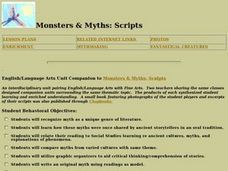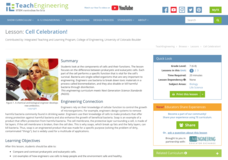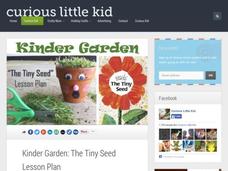Curated OER
Monster and Myths: Scripts
Students explore characteristics of the myth genre. In this myth lesson, students become familiar with various myths and the cultures they were derived from. Students compare in a graphic organizer. Students write original myths and...
Curated OER
Sergei Prokofiev's "peter And the Wolf": Learning And Creating
Students write their own version of "Peter and the Wolf". They explore the characters and the instruments that represent the characters. They use graphic organizing software to brainstorm ideas for characters and story lines for...
Curated OER
Cornplanter and the Fate of His Land
Young scholars explore Chief Cornplanter and his importance as the leader of the Seneca tribe. In this Chief Cornplanter lesson, students examine how the Seneca land was taken over by the right of eminent domain. Young scholars answer...
Curated OER
Explore the Animal World
Third graders use a variety of resources to do research on an animal. Their final project is a graphic organizer for display and an informative multimedia slide show.
Curated OER
European Vacation
Ninth graders work in groups of two or three to plan a trip through Europe. They present a storyboard for approval, outlining their graphics and display pages. They present their trip to the class using PowerPoint. This is displayed...
Curated OER
An Uplifting Experience
Fifth graders research and complete a graphic organizer about the principles of flight. In this aviation lesson, 5th graders experiment to understand the work of Daniel Bernouli and his discoveries about air pressure. Students create...
Curated OER
The Impact
Students investigate the impact inventions have on society. In this technology lesson, students review the facts they learned about famous inventors and brainstorm an invention that can improve people's lives. Students use a graphic...
Teach Engineering
Cell Celebration!
Are you eukaryotic? (Answer: Yes.) The first of six installments in the Cells units teaches pupils about the similarities and differences of prokaryotes and eukaryotes. It also covers the functions of various cell components in both...
Teach Engineering
Edible Rovers
The good thing about building this rover is you get to eat it afterwards. Pairs determine rover parts they want to include in their design based upon their cost and usefulness. The teams design their rovers, build them from edible...
Teach Engineering
Properties of Mixtures vs. Solutions: Mix It Up!
Now it becomes crystal clear why the unit is called Mixtures and Solutions. The fifth installment of a six-part unit explores mixtures and solutions. After viewing a demonstration on mixing pebbles with water, salt with water, and...
Teach Engineering
Alloy Advantage
Mix it up by using an intriguing resource that teaches young metallurgists that alloys are a metal mixture. They learn about the advantages of using alloys over pure metals and investigate titanium alloys as an example to finish the...
Teach Engineering
Backyard Weather Station
Challenge young meteorologists to apply their knowledge of weather to build their own weather stations. The resource provides the directions to build a weather station that contains a wind vane, barometer, thermometer, and rain gauge....
Teach Engineering
Cell Membrane Structure and Function
Teach your class how to get out of a cell — or break in. The third installment in a seven-part series introduces the class to cell membranes and their functions. The lesson plan includes information to present to the class,...
Teach Engineering
The Building Blocks of Matter
Everything can be reduced to atoms. The first installment of a six-part Mixtures and Solutions unit focuses on the building blocks of matter. Scholars review basic atomic structure, including protons, neutrons, and electrons, in...
Teach Engineering
Can You Take the Pressure?
Do not let the pressure get to you. The first lesson in a unit of 22 introduces the concept of air pressure. Using background knowledge, the resource gives teachers the information they need to discuss how people measure air pressure and...
Teach Engineering
Life Cycles
Breathe some life into product design. Pupils learn about the stages of product creation, use, and disposal—sometimes called a cradle-to-grave assessment. They see how this cycle relates to the life cycle of organisms.
Teach Engineering
Energy Forms, States and Conversions
Even magicians can't make energy disappear. In a discussion-based activity, young scientists learn about energy forms and conversions. They see how energy is neither created nor destroyed; it just changes forms. This is the 11th...
Teach Engineering
Wetting and Contact Angle
Explore terminology related to water droplets. The sixth installment of a nine-part series teaches young scientists about wetting and contact angles between water droplets and surfaces. It also distinguishes between hydrophobic and...
Teach Engineering
Superhydrophobicity – The Lotus Effect
Discover and demonstrate the Lotus Effect and superhydrophobic surfaces with the eighth installment of a nine-part series that teaches scholars about surfaces that exhibit superhydrophobicity. The lesson continues also describes...
Teach Engineering
Determining Densities
Don't be dense—use a robust resource. The second installment of a five-part Floaters and Sinkers unit has learners determine the densities of several objects. As part of the activity, they learn the displacement method for finding...
Freecloud Design
Monster Physics™
Physics fanatics will shriek over this monster-themed construction application! They design an invention with the intention of competing one of 50 missions and test it out with real physics applications.
NASA
How Does a Hurricane Form?
Young meteorologists examine the formation of a hurricane in a resource focused on severe weather conditions. Once they learn that a hurricane is also a tropical cyclone, and detail the different levels associated with tropical storms,...
Curated OER
Unit 3: Scientific Writing
Write-on! Demonstrate a writing model and support learners as they write an informational essay on a water resource issue of your (or their) choosing. The lesson plan provides a well-scaffolded summative writing experience that wraps up...
University of Minnesota
Connect the Neurons!
Create a neuron frenzy as your pupils play the part of the neurons. An engaging lesson creates a human chain of neurons that pass cotton balls posing as neurotransmitters. Scholars learn about pre- and post-synapses as they complete the...

























